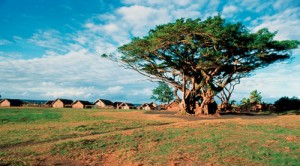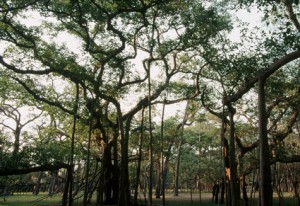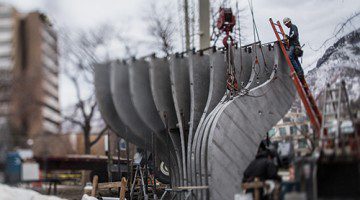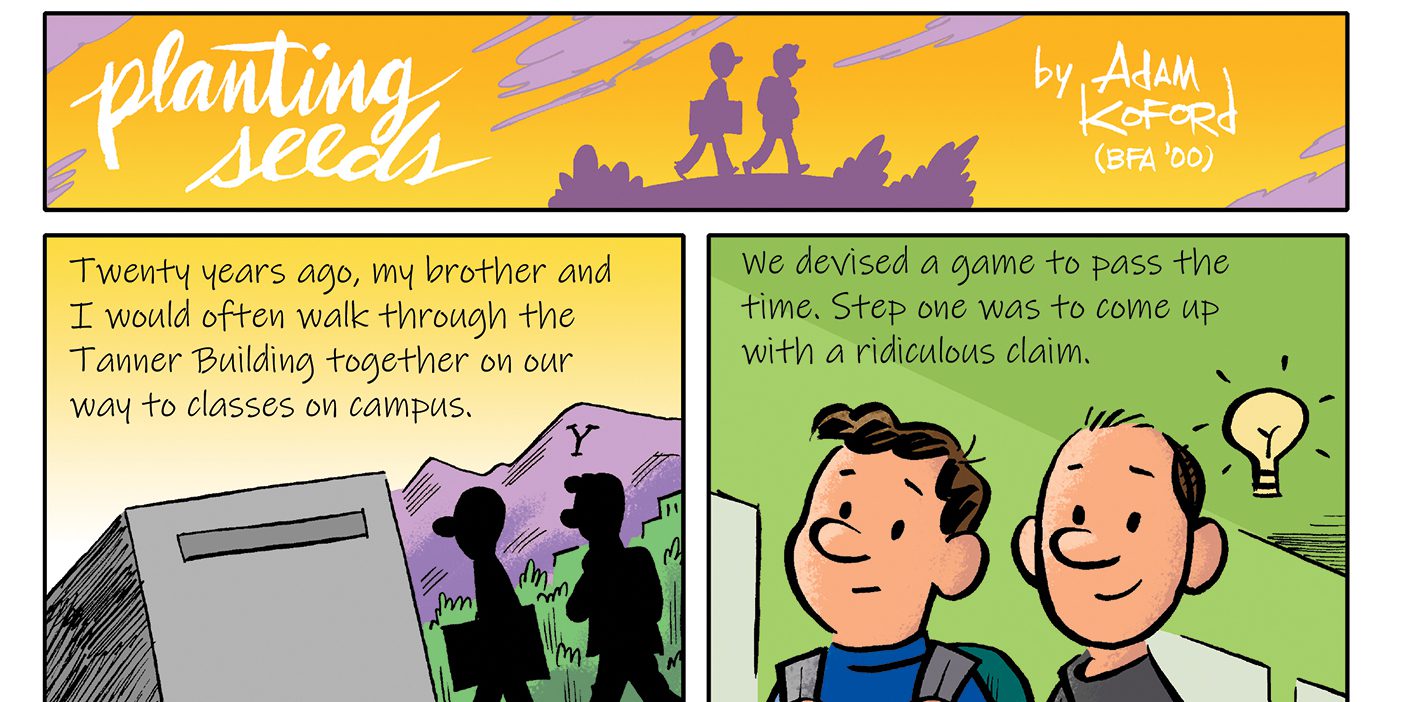
As the parent trunk of the Church Educational System banyan tree, BYU sends out branches of influence spreading around the earth and touching down to bless lives in distant places
By President Merrill J. Bateman
It seems only a short time ago that Brigham Young University completed its first century. Now one-fourth of the second century has elapsed. I remember the interest among the faculty and students in 1975 as the university celebrated the achievements of the first 100 years. Excitement surrounded President Spencer W. Kimball’s second-century address—an October 1975 devotional in which he provided guideposts for the future and spoke of BYU becoming an “educational Everest” (“The Second Century of Brigham Young University,” Speeches of the Year, 1975 [Provo: BYU Press, 1976], p. 244). His vision for BYU in its second century parallels this year’s Annual University Conference theme, President Brigham Young’s admonition that “we should be a people of profound learning” (Journal of Discourses [JD] [London: Latter-day Saints Book Depot, 1854–86], vol. 8, p. 40). The thoughts of both Presidents Young and Kimball are similar to those echoed by other prophets of this dispensation. In fact, President John Taylor not only believed we should become a learned people but foresaw the day of Zion’s excellence. He stated:
You will see the day that Zion will be as far ahead of the outside world in everything pertaining to learning of every kind as we are to-day in regard to religious matters. You mark my words, and write them down, and see if they do not come to pass. [JD, vol. 21, p. 100]
In like manner, President Gordon B. Hinckley has spoken of the importance of obtaining an education and has counseled members that they are under “commandment to continue to study and to learn” (Teachings of Gordon B. Hinckley [Salt Lake City: Deseret Book, 1997], p. 300).
None of us can assume that he has learned enough. As the door closes on one phase of life, it opens on another, where we must continue to pursue knowledge. Ours ought to be a ceaseless quest for truth. [Teachings, p. 301]
The words of our prophets, present and past, inspire us toward educational excellence. They remind us of the intellectual and spiritual foundations provided by those who preceded us and upon which we build. They point to the future of becoming a people of profound learning and inquiry.
Leaders and Teachers
The role of Brigham Young University during the first 100 years was clear. It was to strengthen members and provide faithful leaders and teachers for the Church. Brigham Young Academy principal Karl G. Maeser, faced with numerous problems in the 1880s, decided to leave the young school. He changed his mind, however, when in a dream he saw tens of thousands of Church members who would be blessed by a modern university on Temple Hill.
Three decades later BYU President Franklin S. Harris, ’07, after a meeting with the board of trustees in 1921, recognized the university’s role in providing leaders in all disciplines. He said:
The President of the Church, Commission of Education, and all who have anything to do with the Church schools are determined to make this the great Church University. . . . When someone tells you that all the institution will do will be to prepare teachers, tell them they don’t know what they are talking about. There is nothing greater than to be a teacher, but the school will have to prepare leaders in other directions just as well. . . . All Mormondom cannot be educated here, but I hope to see the time when two of a city . . . will come here to become leaders. [In Ernest L. Wilkinson and W. Cleon Skousen, Brigham Young University: A School of Destiny (Provo: BYU Press, 1976), p. 239]
In addition President Heber J. Grant recognized the role of BYU in providing teachers for the Church educational system. In the depths of the 1930s depression, financial pressures caused the First Presidency to announce the closure of all Church schools, including Brigham Young University. In a meeting following the announcement, a key member of the BYU Board of Trustees asked President Grant who would provide teachers for the Church. After a moment of reflection, the president reversed his decision regarding this institution. Most other Church schools were closed or given to the public sector.
From the beginning the mandate was clear. Brigham Young University’s role was to build testimony, prepare students for their work in the world, and provide teachers and leaders for the Church.
A Model of Profound Learning

The Parent trunk in provo must be extraordinary both spiritually and secularly if the reach is to be infinite. In particular, it just be a part of the “True Vine”.
As Church growth accelerated in the 1970s and the university began serving a smaller and smaller fraction of the membership, questions regarding its role and purpose began to surface. If the university could not accommodate all members who desired to attend or even “two of a city,” why should the Church support it? Although BYU produces more teachers than any other university in the world, is it enough to justify its existence? Even with 9,000 graduates per year, the number of leaders produced is relatively small in a kingdom of millions.
President Kimball provided an answer to these questions as he illustrated the importance of the university to the Church educational system in his second-century address. In the early part of his speech, he referred to Principal Maeser’s description of Brigham Young Academy as “the parent trunk of the great education banyan tree” (in Alma P. Burton, Karl G. Maeser: Mormon Educator [Salt Lake City: Deseret Book, 1953], p.73). President Kimball also noted that President David O. McKay had described BYU as “the hub of the Church educational wheel” and that others had referred to this institution as “the flagship.” President Kimball then said:
However it is stated, the centrality of this University to the entire system is a very real fact of life. What I say to you, therefore, must take note of things beyond the borders of this campus, but not beyond its influence. [“Second Century,” p. 244]
In this same light President Hinckley spoke to the priesthood of the Church in October 1999 regarding the importance of Brigham Young University. He began with the Lord’s decree in section 88 of the Doctrine and Covenants, verses 78 to 80, which puts the Church under obligation “not only to learn of ecclesiastical matters but also of secular matters” (“Why We Do Some of the Things We Do,” Ensign, November 1999, p. 52). He then said, “We can accommodate only a relatively few. . . . The number who can be accommodated on campus is finite, but the influence of the university is infinite. Tremendous efforts are being made to enlarge and extend that influence.” He pointed out that “the university has brought much favorable notice to the Church” through the quality of its academic and athletic programs. Also, the university “has become known for standards and ideals . . . which have let the world know of those things in which we believe” (“Why We Do,” pp. 52–53). Speaking of the various BYU campuses, he concluded by saying:
We shall keep these as flagships testifying to the great and earnest commitment of this Church to education, both ecclesiastical and secular, and while doing so prove to the world that excellent secular learning can be gained in an environment of religious faith. [“Why We Do,” p. 53]
As the Church has grown and the numbers accommodated by the university on campus have diminished in relative terms, the prophets have stated that the university is to be a model of profound spiritual and secular learning, a community known for high standards and ideals, a light whose special glow extends beyond campus borders, and an institution whose influence is infinite. The model is unique.
The Parent Trunk
As I reflect on the words of the prophets, the aptness of Karl G. Maeser’s banyan tree comparison becomes clear. A banyan tree spreads by sending out aerial branches that reach down to the earth and become rooted as additional trunks. We are “the parent trunk,” with three others in the form of BYU—Hawaii, BYU—Idaho, and LDS Business College. We are at the heart of the Church Educational System with the responsibility of preparing teachers and providing learning materials. To the extent that we educate teachers and leaders for the seminary and institute programs, they are branches, and we extend our reach ecclesiastically.
The parent trunk consists of the 29,000 students gathered from all 50 states and more than 115 countries. In addition, 1,600 full-time and 600 part-time faculty assisted by 2,800 staff are also part of the tree. It is a community that speaks 85 languages and teaches more than 60. Overriding the many languages is one common language—that of the Spirit—which creates bonds that turn a diverse community into a unique university. The aerial branches of the parent are spreading carefully around the earth, touching down to bless LDS lives in distant places. BYU‘s influence spreads both secularly and spiritually through faculty and staff contact with peers, performing groups traveling the world, independent study programs, education days and weeks, and radio and television. The quality of BYU faculty and student research and creative work is making headlines almost weekly.
In today’s world the spread of BYU‘s influence is accelerating as new technologies allow students anywhere in the world at any time to connect with us. This has helped fully matriculated students both on campus and in Study Abroad programs. In addition, Independent Study has grown from 35,000 off-campus students in 1996 to more than 100,000 in the current year. This has allowed the Division of Continuing Education to return to the university a substantial sum to support advances in the curriculum both on and off campus. BYUTV, initiated in late 1999, now extends the campus reach to all states within the United States and to a large number of foreign countries. The branches and roots will expand until the tree encompasses the earth. The tree will literally become a forest.
A Fully Anointed University
A strong trunk is essential if the branches and secondary roots are to receive quality nourishment. The parent trunk in Provo must be extraordinary both spiritually and secularly if the reach is to be infinite. In particular, it must be a part of the “true vine” (John 15:1) if it is to play a central role in the kingdom’s educational system.
I firmly believe that Brigham Young University is a “school of destiny,” but the fulfillment of prophetic vision requires that we lengthen our step. President Hinckley had a vision of 100 temples by the end of the century. The vision became a reality because of the planning and execution by him and others. Prophetic utterances become reality when people believe and act. Faith is necessary to ascend the higher mountains that lie ahead.
In “The Second Century of Brigham Young University,” President Kimball quoted Ernest L. Wilkinson, ’21, a former president of BYU and the editor of Brigham Young University: The First One Hundred Years:
To go to BYU is something special. There were Brethren who had dreams regarding the growth and maturity of Brigham Young University, even to the construction of a temple on the hill they had long called Temple Hill, yet “dreams and prophetic utterances are not self-executing. They are fulfilled . . . by righteous and devoted people making prophecies come true.” [In “Second Century,” pp. 255–56; see also School of Destiny, p. 876]
President Kimball spoke of this same principle. He said:
We must do more than ask the Lord for excellence. Perspiration must precede inspiration; there must be effort before there is excellence. We must do more than pray for these outcomes at BYU, though we must surely pray. We must take thought. We must make effort. We must be patient. We must be professional. We must be spiritual. Then, in the process of time, this will become the fully anointed university of the Lord about which so much has been spoken in the past. [“Second Century,” p. 253]
The Fruits of the Tree
President Kimball hoped for the day when Brigham Young University and the Church Educational System would produce “brilliant stars in drama, literature, music, sculpture, painting, science, and in all the scholarly graces” (“Second Century,” p. 247; emphasis added). His hopes and expectations are now coming to pass. Think of the numerous national and international awards received by our students, faculty, and staff during the past few years. From fine arts to the sciences, from humanities to business, from print to graphics to dining services, stars have arisen, and more will follow. Higher mountains and vistas still lie ahead, but this institution is beginning to lighten the sky. President Kimball’s vision will be fulfilled as the university approaches more closely the model of secular and spiritual learning described by President Hinckley.
Eventually the banyan tree will be transformed into a beautiful white tree with fruit that is delicious to the taste. The tree will shine as a standard for the nations because of its perfected

Eventually the Banyan Tree will be transformed into a beautiful white tree with fruit that is delicious to the taste. The tree will shine as a standard for the nations.
dual nature. The light emanating from the tree will be of infinite power, and people will embrace the light and their knowledge will become perfect.
Most of us have planted the seed of the tree in our hearts. We have nourished the seed and it has sprouted. A swelling motion has told us that it is a good seed (see Alma 32:28–43). We do not know all things now, but if we continue we will become an integral part of the tree and enjoy its perfect light. May the Lord bless us to this end is my prayer in the name of Jesus Christ, amen.
Merrill J. Bateman is the president of BYU. This article is condensed from an address given to BYU faculty and staff at Annual University Conference, Aug. 27, 2001. The full text of this speech is online at speeches.byu.edu/.









